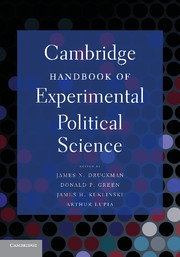Book contents
- Frontmatter
- Contents
- List of Tables
- List of Figures
- Contributors
- Acknowledgments
- INTRODUCTION
- PART I DESIGNING EXPERIMENTS
- 2 Experiments
- 3 Internal and External Validity
- 4 Students as Experimental Participants
- 5 Economics versus Psychology Experiments
- PART II THE DEVELOPMENT OF EXPERIMENTS IN POLITICAL SCIENCE
- PART III DECISION MAKING
- PART IV VOTE CHOICE, CANDIDATE EVALUATIONS, AND TURNOUT
- PART V INTERPERSONAL RELATIONS
- PART VI IDENTITY, ETHNICITY, AND POLITICS
- PART VII INSTITUTIONS AND BEHAVIOR
- PART VIII ELITE BARGAINING
- PART IX ADVANCED EXPERIMENTAL METHODS
- AFTERWORD
- Name Index
- Subject Index
- References
2 - Experiments
An Introduction to Core Concepts
Published online by Cambridge University Press: 05 June 2012
- Frontmatter
- Contents
- List of Tables
- List of Figures
- Contributors
- Acknowledgments
- INTRODUCTION
- PART I DESIGNING EXPERIMENTS
- 2 Experiments
- 3 Internal and External Validity
- 4 Students as Experimental Participants
- 5 Economics versus Psychology Experiments
- PART II THE DEVELOPMENT OF EXPERIMENTS IN POLITICAL SCIENCE
- PART III DECISION MAKING
- PART IV VOTE CHOICE, CANDIDATE EVALUATIONS, AND TURNOUT
- PART V INTERPERSONAL RELATIONS
- PART VI IDENTITY, ETHNICITY, AND POLITICS
- PART VII INSTITUTIONS AND BEHAVIOR
- PART VIII ELITE BARGAINING
- PART IX ADVANCED EXPERIMENTAL METHODS
- AFTERWORD
- Name Index
- Subject Index
- References
Summary
The experimental study of politics has grown explosively in the past two decades. Part of that explosion takes the form of a dramatic increase in the number of published articles that use experiments. Perhaps less evident, and arguably more important, experimentalists are exploring topics that would have been unimaginable only a few years ago. Laboratory researchers have studied topics ranging from the effects of media exposure (Iyengar and Kinder 1987) to the conditions under which groups solve collective action problems (Ostrom, Walker, and Gardner 1992), and, at times, have identified empirical anomalies that produced new theoretical insights (McKelvey and Palfrey 1992). Some survey experimenters have developed experimental techniques to measure prejudice (Kuklinski, Cobb, and Gilens 1997) and its effects on support for policies such as welfare or affirmative action (Sniderman and Piazza 1995); others have explored the ways in which framing, information, and decision cues influence voters' policy preferences and support for public officials (Druckman 2004; Tomz 2007). And although the initial wave of field experiments focused on the effects of campaign communications on turnout and voters' preferences (Eldersveld 1956; Gerber and Green 2000; Wantchekon 2003), researchers increasingly use field experiments and natural experiments to study phenomena as varied as election fraud (Hyde 2009), representation (Butler and Nickerson 2009), counterinsurgency (Lyall 2009), and interpersonal communication (Nickerson 2008).
- Type
- Chapter
- Information
- Cambridge Handbook of Experimental Political Science , pp. 15 - 26Publisher: Cambridge University PressPrint publication year: 2011
References
- 20
- Cited by

